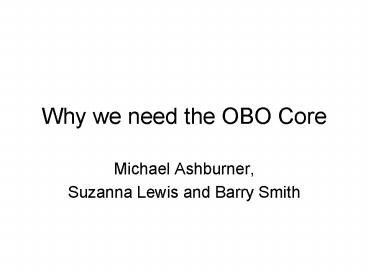Why we need the OBO Core - PowerPoint PPT Presentation
1 / 21
Title: Why we need the OBO Core
1
Why we need the OBO Core
- Michael Ashburner,
- Suzanna Lewis and Barry Smith
2
DO
- Accident to powered aircraft, other and
unspecified, injuring occupant of military
aircraft, any rank - Other accidental submersion or drowning in water
transport accident injuring occupant of other
watercraft crew
3
DO
- Fall on stairs or ladders in water transport
injuring occupant of small boat, unpowered - Railway accident involving collision with
rolling stock and injuring pedal cyclist - Non-traffic accident involving motor-driven snow
vehicle injuring pedestrian
4
DO
- Fitting and adjustment of wheelchair
5
Disease Ontology
- Fitting and adjustment of wheelchair
- is_a disease
6
Goal of the OBO Core project
- To introduce some of the features of scientific
peer review into biomedical ontology development
7
Some OBO ontologies are of high quality
- Some not
- How to avoid poisoning of the wells?
8
Further arguments
- Some OBO ontologies are already designated as OBO
Core ontologies - The community wanted it so we need to publish
the criteria - Several groups within the Center want to do this
- Several new groups without the Center want us to
do this (preNCIT, FuGO, ...) - It is entirely voluntary
9
NCI Thesaurus
- http//www.cbd-net.com/index.php/search/show/9384
64 - Review of NCI Thesaurus and Development of
Plan to Achieve OBO Compliance
10
Further arguments
- The idea is part of what we agreed to do in the
BISTI proposal - We will take steps to forge a common set of
principles (best practices) and a common
methodology for those active in ontology building
in the life sciences - Core 6 needs an explicit statement of methodology
and criteria in order to do its work
11
Further arguments
- It is an exciting and original alternative to the
wiki/democracy/schemaweb based approaches à la
CBioC - It will provide a small reward for those doing
good work in science-based ontology - It will provide a step towards the day when
interoperability through controlled vocabularies
can be enforced through agreements with
biological research groups, clinical guidelines
bodies, and scientific journals
12
Further arguments
- No objections have been made to the actual
criteria proposed, except ... - Orthogonality ontology groups who choose to be
part of the OBO Core thereby commit themselves to
collaborating to resolve disagreements which
arise where their respective domains overlap - (They commit themselves to conceiving ontology as
a science, not as a hobby)
13
How to achieve orthogonality
- Good ontologies (FMA) can incorporate alternative
views or partitions of the same domain (regional
partition, structural partition ...) - Some ontologies (NCIT) will be Application
Ontologies, which commit to maintaining
compatibility with Reference Ontologies covering
overlapping domains
14
Some OBO ontologies are of high quality
- Some are not
- Compare a scientific journal which publishes
both high-quality peer-reviewed articles, and
some other stuff, ... - but does not distinguish between them
15
OBO CORE EVALUATION CRITERIA
- http//smi.stanford.edu/projects/cbio/mwiki-intern
al/images/2/21/OBO-criteria-v7.doc
16
- The ontologies are developed in collaboration
with other OBO core ontologies. When
disagreements arise the rationale for these
disagreements should be documented, and efforts
will be undertaken, for example, within the
framework of the Centers Dissemination
Workshops, in order to resolve these
disagreements. - The ontology is open and available to be used by
all - The ontology is in, or can be instantiated in, a
common shared syntax. See http//obo.sf.net/ - The ontology possesses a unique identifier space.
- The ontology provider has procedures for
identifying distinct successive versions. - The ontology is well-documented.
- The ontology has a plurality of independent
users. - The ontology has clearly specified and clearly
delineated content. - The ontology includes textual definitions for all
terms. - The ontology uses relations which are
unambiguously defined following the pattern of
definitions laid down in the OBO Relation
Ontology.
17
OBO Relation Ontology
Foundational is_apart_of
Spatial located_incontained_inadjacent_to
Temporal transformation_ofderives_frompreceded_by
Participation has_participanthas_agent
18
How to use the OBO Relation Ontology
- Tell curators to keep in mind that when they
make e.g. an - A is_a B
- assertion in an ontology, they need to remember
that this is a statement about As to the effect
that each A is a B.
19
OBO CORE EVALUATION CRITERIA
- Further criteria will be added over time in
order to bring about a gradual improvement in the
quality of ontologies included in the OBO core.
20
Reference Ontology vs. Application Ontology
- A reference ontology is analogous to a scientific
theory it seeks to optimize descriptive or
representational adequacy to its subject matter
to the maximal degree that is compatible with the
constraints of computational usefulness. - An application ontology is comparable to an
engineering artifact such as a software tool. It
is constructed for specific practical purposes.
21
Reference Ontology vs. Application Ontology
- Application ontologies often built afresh for
each new task commonly introducing not only
idiosyncrasies of format or logic, but also
simplifications or distortions of their
subject-matters. - To solve this problem OBO Core proposes a
methodology according to which application
ontology development shoud take place always
against the background of a formally robust
reference ontology framework































